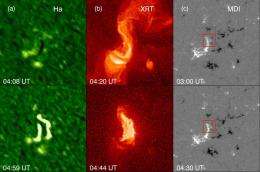A New View of Coronal Waves

(PhysOrg.com) -- The corona is the hot outer region of the sun's atmosphere. The corona is threaded by magnetic fields that loop and twist upwards from the sun's surface, driven by motions of its dense atmosphere.
When one of these magnetic loops snaps open, it can produce a mass ejection and a flare whose X-rays and ejected particles can disrupt communications on earth. It has been known for about fifteen years that there are roughly circular waves rippling through the corona on a scale that spans the entire solar disk. The possible relationship between these waves and solar eruptions or other active phenomena is an active area of research because of the interest in being able to predict solar storm activity.
Coronal waves are suspected of having significant depth into the atmosphere, but observations from a single orbiting telescope only obtain a two-dimensional picture of wave activity. In 2006, NASA launched the STEREO mission: two identical satellites but in different orbits, to study the three-dimensional structure of solar eruptions.
CfA astronomers Suli Ma, Meredith Wills-Davey, Ting Lin, Gemma Attrill, and Leon Golub used STEREO, together with other sun-observing spacecraft, to investigate the 3-D behavior of coronal waves. In a paper appearing in this week's Astrophysical Journal, they present their analysis of a wave that appeared two years ago, on December 7, 2007, and that produced an eruption and ejection a few minutes later.
The ultraviolet images of the coronal wave obtained from each STEREO satellite are quite different at the start of the observations, but look more and more alike with time. By considering projection effects and the physics of coronal ejections, the scientists conclude that the three-dimensional structure of the waves can significantly influence their observed physical properties.
Provided by Harvard-Smithsonian Center for Astrophysics (news : web)



















